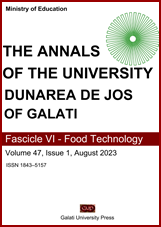Folate production and its distribution during growth of lactic acid bacteria isolated from fermented food and breast milk
Abstract
Production of folate by lactic acid bacteria (LAB) isolated from tempe, fermented mustard, kefir, tapai, and breast milk was analyzed after 24 h of growth in folate-free media. The LAB isolates with the highest folate production were further investigated for folate distribution in intracellular and extracellular cells in a folate-free medium for 48 h. The two main forms of folates, i.e., tetrahydrofolate (THF) and 5-methyl-tetrahydrofolate (5-MTHF), as well as folic acid, were detected and quantified using the HPLC-DAD method with each folate standard as calibration curves. Two folate peaks were found in the spent medium of folate-producing isolates; one of them was identified as 5-MTHF, while the other peak was identified as other folates. Lacticaseibacillus rhamnosus R23 from breast milk and Limosilactobacillus fermentum JK13 from kefir granules were the selected folate-producing isolates, with the production of total folates at 98.37 mg/ml and 85.67 mg/ml, respectively, after 24 h of incubation. The two isolates showed nearly similar patterns of intra- and extracellular folate distribution; that is, extracellular folate excreted into the media has a much higher proportion than intracellular folate. Therefore, the two LAB isolates can be utilized for extracellular folate production.


